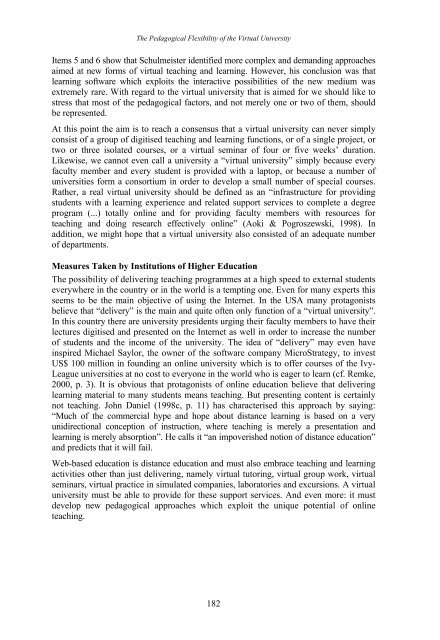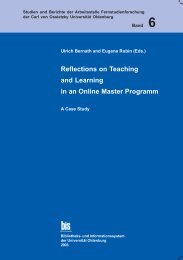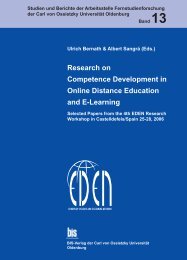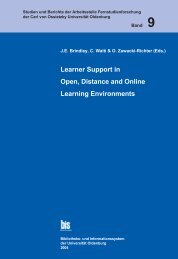Distance Education in Transition - Master of Distance Education ...
Distance Education in Transition - Master of Distance Education ...
Distance Education in Transition - Master of Distance Education ...
Create successful ePaper yourself
Turn your PDF publications into a flip-book with our unique Google optimized e-Paper software.
The Pedagogical Flexibility <strong>of</strong> the Virtual University<br />
Items 5 and 6 show that Schulmeister identified more complex and demand<strong>in</strong>g approaches<br />
aimed at new forms <strong>of</strong> virtual teach<strong>in</strong>g and learn<strong>in</strong>g. However, his conclusion was that<br />
learn<strong>in</strong>g s<strong>of</strong>tware which exploits the <strong>in</strong>teractive possibilities <strong>of</strong> the new medium was<br />
extremely rare. With regard to the virtual university that is aimed for we should like to<br />
stress that most <strong>of</strong> the pedagogical factors, and not merely one or two <strong>of</strong> them, should<br />
be represented.<br />
At this po<strong>in</strong>t the aim is to reach a consensus that a virtual university can never simply<br />
consist <strong>of</strong> a group <strong>of</strong> digitised teach<strong>in</strong>g and learn<strong>in</strong>g functions, or <strong>of</strong> a s<strong>in</strong>gle project, or<br />
two or three isolated courses, or a virtual sem<strong>in</strong>ar <strong>of</strong> four or five weeks’ duration.<br />
Likewise, we cannot even call a university a “virtual university” simply because every<br />
faculty member and every student is provided with a laptop, or because a number <strong>of</strong><br />
universities form a consortium <strong>in</strong> order to develop a small number <strong>of</strong> special courses.<br />
Rather, a real virtual university should be def<strong>in</strong>ed as an “<strong>in</strong>frastructure for provid<strong>in</strong>g<br />
students with a learn<strong>in</strong>g experience and related support services to complete a degree<br />
program (...) totally onl<strong>in</strong>e and for provid<strong>in</strong>g faculty members with resources for<br />
teach<strong>in</strong>g and do<strong>in</strong>g research effectively onl<strong>in</strong>e” (Aoki & Pogroszewski, 1998). In<br />
addition, we might hope that a virtual university also consisted <strong>of</strong> an adequate number<br />
<strong>of</strong> departments.<br />
Measures Taken by Institutions <strong>of</strong> Higher <strong>Education</strong><br />
The possibility <strong>of</strong> deliver<strong>in</strong>g teach<strong>in</strong>g programmes at a high speed to external students<br />
everywhere <strong>in</strong> the country or <strong>in</strong> the world is a tempt<strong>in</strong>g one. Even for many experts this<br />
seems to be the ma<strong>in</strong> objective <strong>of</strong> us<strong>in</strong>g the Internet. In the USA many protagonists<br />
believe that “delivery” is the ma<strong>in</strong> and quite <strong>of</strong>ten only function <strong>of</strong> a “virtual university”.<br />
In this country there are university presidents urg<strong>in</strong>g their faculty members to have their<br />
lectures digitised and presented on the Internet as well <strong>in</strong> order to <strong>in</strong>crease the number<br />
<strong>of</strong> students and the <strong>in</strong>come <strong>of</strong> the university. The idea <strong>of</strong> “delivery” may even have<br />
<strong>in</strong>spired Michael Saylor, the owner <strong>of</strong> the s<strong>of</strong>tware company MicroStrategy, to <strong>in</strong>vest<br />
US$ 100 million <strong>in</strong> found<strong>in</strong>g an onl<strong>in</strong>e university which is to <strong>of</strong>fer courses <strong>of</strong> the Ivy-<br />
League universities at no cost to everyone <strong>in</strong> the world who is eager to learn (cf. Remke,<br />
2000, p. 3). It is obvious that protagonists <strong>of</strong> onl<strong>in</strong>e education believe that deliver<strong>in</strong>g<br />
learn<strong>in</strong>g material to many students means teach<strong>in</strong>g. But present<strong>in</strong>g content is certa<strong>in</strong>ly<br />
not teach<strong>in</strong>g. John Daniel (1998c, p. 11) has characterised this approach by say<strong>in</strong>g:<br />
“Much <strong>of</strong> the commercial hype and hope about distance learn<strong>in</strong>g is based on a very<br />
unidirectional conception <strong>of</strong> <strong>in</strong>struction, where teach<strong>in</strong>g is merely a presentation and<br />
learn<strong>in</strong>g is merely absorption”. He calls it “an impoverished notion <strong>of</strong> distance education”<br />
and predicts that it will fail.<br />
Web-based education is distance education and must also embrace teach<strong>in</strong>g and learn<strong>in</strong>g<br />
activities other than just deliver<strong>in</strong>g, namely virtual tutor<strong>in</strong>g, virtual group work, virtual<br />
sem<strong>in</strong>ars, virtual practice <strong>in</strong> simulated companies, laboratories and excursions. A virtual<br />
university must be able to provide for these support services. And even more: it must<br />
develop new pedagogical approaches which exploit the unique potential <strong>of</strong> onl<strong>in</strong>e<br />
teach<strong>in</strong>g.<br />
182





